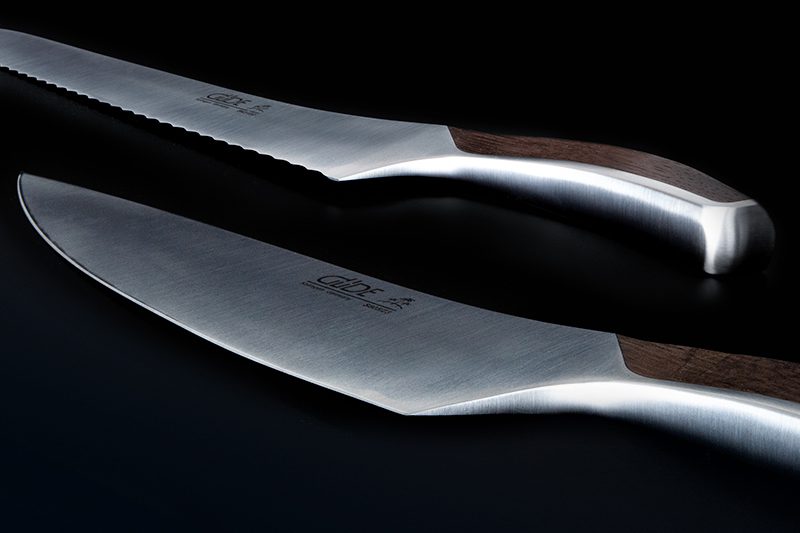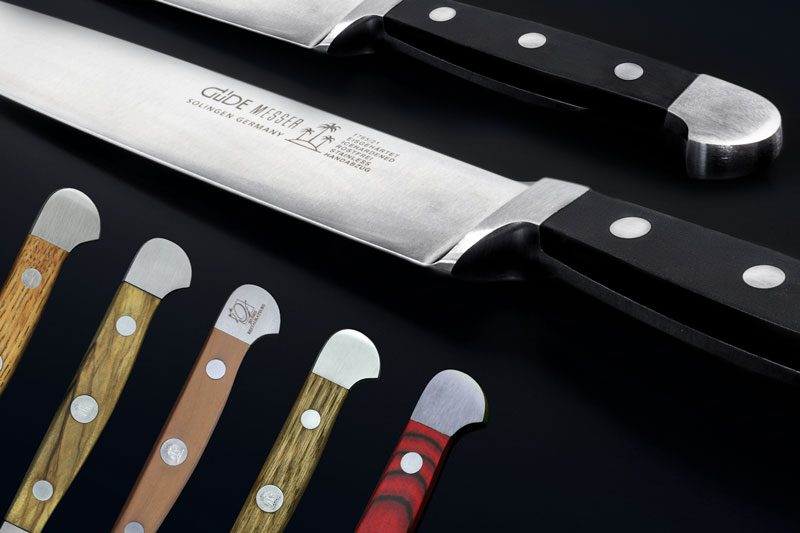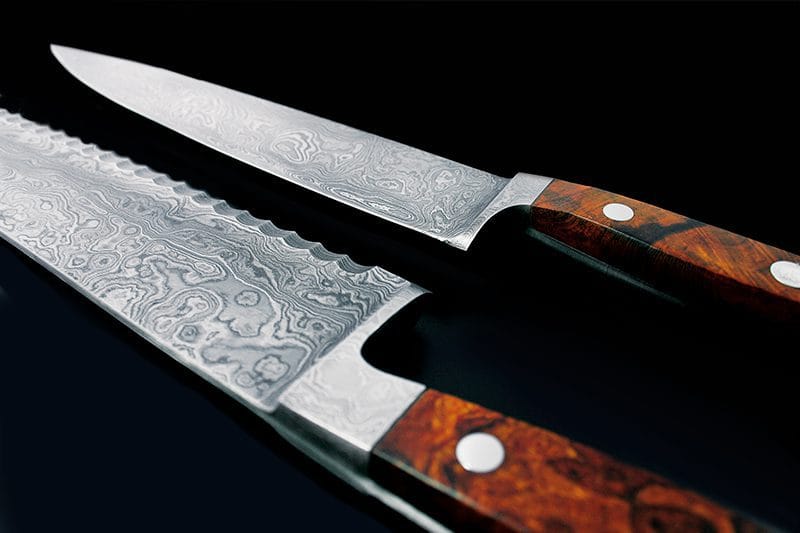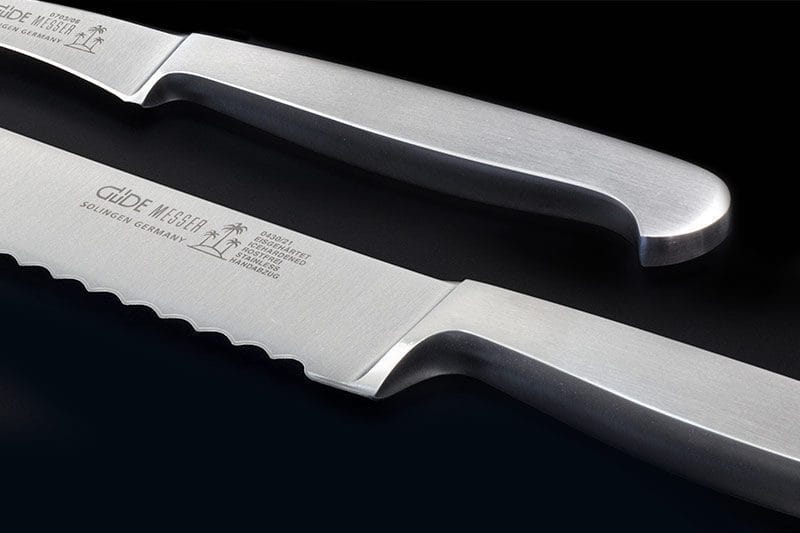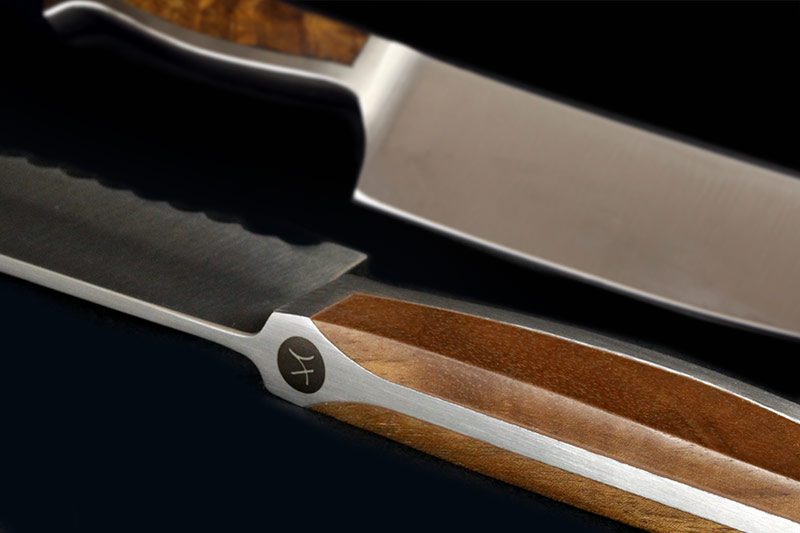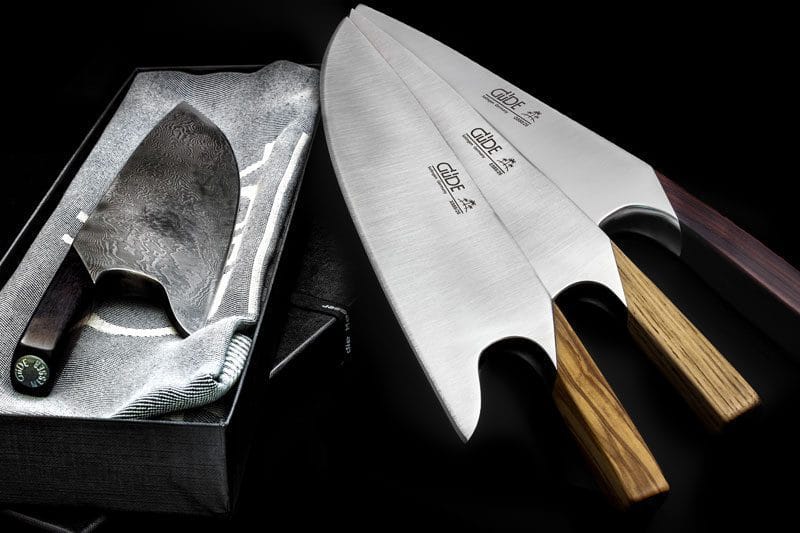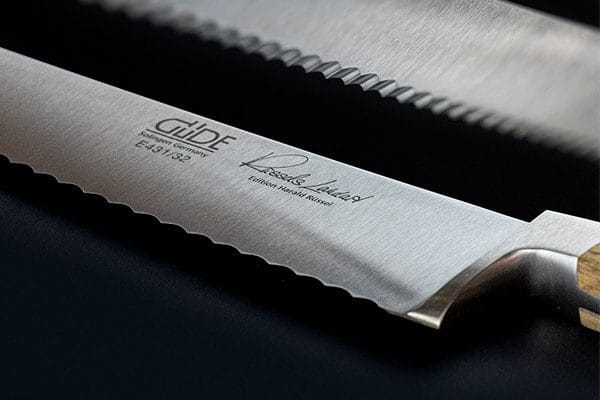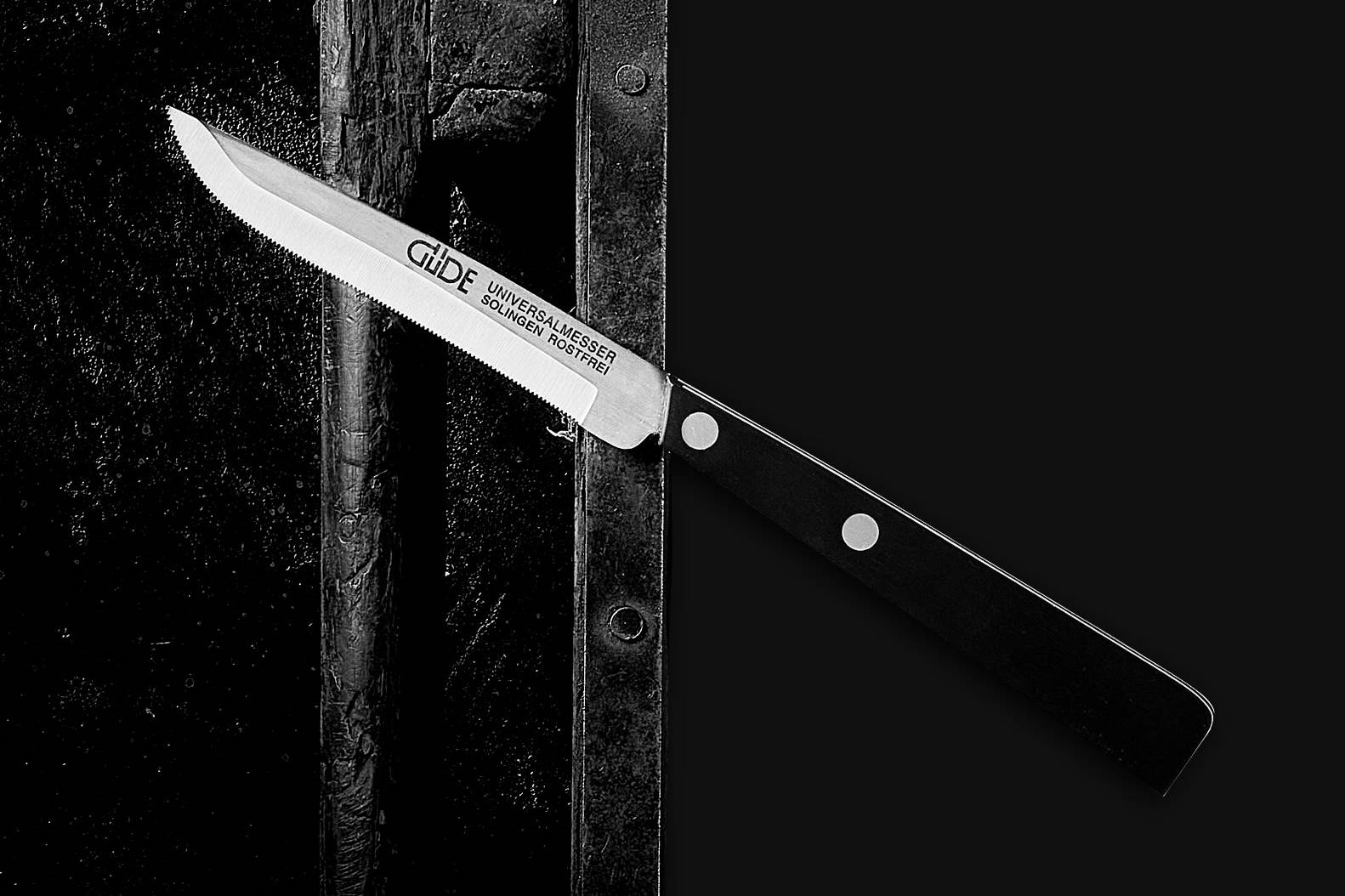ALPHA Mikarta
The handles of this knife series are made of a fibre-synthetic resin composite, called Mikarta . Grinding the handles results in an individual structure and pattern, so that no two knives are alike. Like all the knives in the Alpha series, the blade of the Alpha Mikarta series is made of chrome-vanadium-molybdenum knife steel and forged by hand from a single piece of steel.
More than 40 further manual operations are necessary to produce a unique piece of Solingen knifemaking art. Because of the Mikarta handles, these knives should not be put in the dishwasher. The blade is stainless, ice-hardened and of course hand-sharpened.

Material
The blade material of knives has to meet a wide range of requirements, some of which are contradictory. It is therefore important to achieve an optimum between the different requirements. A knife steel should be hard, but not too hard, otherwise it would break. But it should also not be too soft, otherwise the knife would become blunt too quickly through wear. That is why the knives in the Alpha Mikarta series from GÜDE are made of a chrome-molybdenum-vanadium knife steel that has an optimum hardness of approx. 57-58 HRc (Rockwell).
The hardness of the knife steel of the series Alpha Mikarta of 57-58 HRc is optimal for the different requirements that a good knife must fulfil.
Thanks to this hardness, the blade of the knives in the Alpha Mikarta series is torsion-resistant and thus guarantees exact guidance of the knife and thus a precise cut.
Production
Knives in the Alpha Mikarta series are drop-forged from one piece of steel. Drop forging ensures high material strength even under dynamic stresses. During drop forging, the entire forging blank is heated and deformed. In up to 55 further steps, the forged blank is turned into a unique handmade knife from the knife manufactory GÜDE.
After the knives have been roughly ground, calibrated and cleaned, the so-called ice-hardening process follows: the knives are cooled to -80 °C to improve the microstructure in the blade steel. In the next step, the knives are tempered in two stages, i.e. heated again and thus made unbreakable. The blade is then pre-ground, followed by pre-grinding of the back of the knife. This is followed by the fine grinding of the back of the knife and the sharpening of the bolster. The inside of the handle is now pre-ground. Pre-grinding of the bolsters is done in 5 steps. This is followed by the fine grinding of the blade. This is also called "pliestening". The handle scales are now adapted to the knife handle. Then the holes for the rivets are drilled. A countersink must be made in the holes for the rivet heads. The handle and the blade are now joined by rivets. The handle scales are roughly ground on the tang and bolster in about five operations. These five operations must be repeated with a finer abrasive belt. Now the back of the knife gets the finest grinding. The fine grinding of the front bolster follows and the knife handles are pre-polished. Then the central decorative rivet is mounted and the handles are finely polished. Then the knife edge, also called the bevel, is ground (stripped) and the trigger is polished. In the next step, the GÜDE logo is etched onto the blade. Then the knives are cleaned and the quality is checked. After that, the knives are put into a sheath for protection. Finally, the shipping bags are fitted with rivets and appropriate labels. The finished knives are now sent to the warehouse for shipping.
Form
In drop forging, the design language is free from the tip of the blade to the end of the handle. A design language like that of Alpha Mikarta is only possible in the drop-forging process. That is why GÜDE has remained true to this proven forging technology since its founding in 1910, now in its fourth generation. An unmistakable feature of many series from GÜDE is the so-called double bolster. A bolster is the thickening of the blade steel. The (front) bolster between the handle and the blade serves both as finger protection and balance weight. The second bolster at the end of the handle gives the knives a better balance. This guarantees the user pleasant and fatigue-free work.
The tang is the part of the steel to which the handle of a knife is attached. If the tang goes from the blade to the end of the handle, it is called a full tang. The knives in the Alpha Mikarta series from GÜDE all have a full tang, as this gives a better balance of the weight.
Since the full tang is completely visible from above and below over the entire length of the handle, it virtually proves that the knives in the Alpha Mikarta series are forged from one piece. No seam, no material transition - simply drop-forged from one piece.
Function
A good knife must be sharp, stay sharp, fit well in the hand and be balanced so that fatigue-free and safe work is guaranteed at all times.
The hardness of the GÜDE blade steel with approx. 57-58 HRc (Rockwell) and the GÜDE bevel angle of approx. 33 degrees ensure optimum sharpness and edge retention of the Alpha Mikarta series. The shape of the handle, the full tang and the double bolster typical of GÜDE guarantee perfect handling and balance of the knives in the Alpha Mikarta series.
In terms of sharpness and edge retention, the bevel angle is of particular importance: because cutting is "physically" the driving of a wedge through a material to be cut. The more acute the angle of the wedge, i.e. the bevel angle, the better this works. The blade angle is the knifemakers' term for the cutting edge, i.e. the sharply ground part of a knife. A sharp bevel angle makes a knife sharper than a dull bevel angle. However, if the bevel angle is too acute, the bevel can break. That is why the knives in the Alpha Mikarta series from GÜDE have an optimum bevel angle of approx. 33 degrees. This angle guarantees sharpness and stability at the same time. The chrome-molybdenum-vanadium knife steel of the Alpha Mikarta series with its hardness of approx. 57-58 HRc (Rockwell) ensures that the sharpness lasts for a long time. The prerequisite is cutting on a suitable cutting surface, e.g. wood or plastic. The proverbial balance of the knives in the Alpha Mikarta series is achieved thanks to the double bolster in combination with the full tang, which creates a counterweight to the blade in the handle area. For the user, this means perfect balance and fatigue-free work. A secure grip is always guaranteed. The front and rear bolsters enclose the hand and protect it from slipping, even when greater force is applied. The knives in the Alpha Mikarta series deliver what the hobby chef expects from a perfect knife. Handmade, drop-forged from one piece, with the experience of centuries of Solingen knifemaking.
Our knife series
We value individuality - especially in the development and optimisation of our knife series. This is reflected in every single blade that leaves our manufactory, in the selection of particularly beautiful and tactile handle materials and a unique ergonomic design that fluently enables and celebrates fast, precise work.
Discover knife icons
THE KNIFE.
Our THE KNIFE. lives up to its name: this all-rounder was conceived, developed and forged by us with a particular focus on perfect ergonomics. Its special shape and balance ensure an automatic over-grip of the hand, which encloses the blade when cutting and thus finds a quasi natural extension in THE KNIFE.
Güde Bread knife
Developed in 1941 by the heir to the manufactory Franz Güde , the special "GÜDE serrated edge" of our bread knives today delights bakers and bread lovers all over the world. The pointed teeth of the unyielding, sharply ground chrome-vanadium-molybdenum steel ensure that breads, baguettes and rolls can be sliced instead of squashed, but also cabbages, melons and crispy crusted roasts can be cut more easily than ever. Unadorned, beautiful handles made of different high-quality materials do the rest for this knife legend of ours.
Utility knife
Our compact all-round talent is handy and effective - not only when it comes to precise work with smaller items. Its fine serration and double-sided hollow grinding make our universal knife the ideal companion for peeling, cutting and slicing vegetables, meat, fruit and co.




